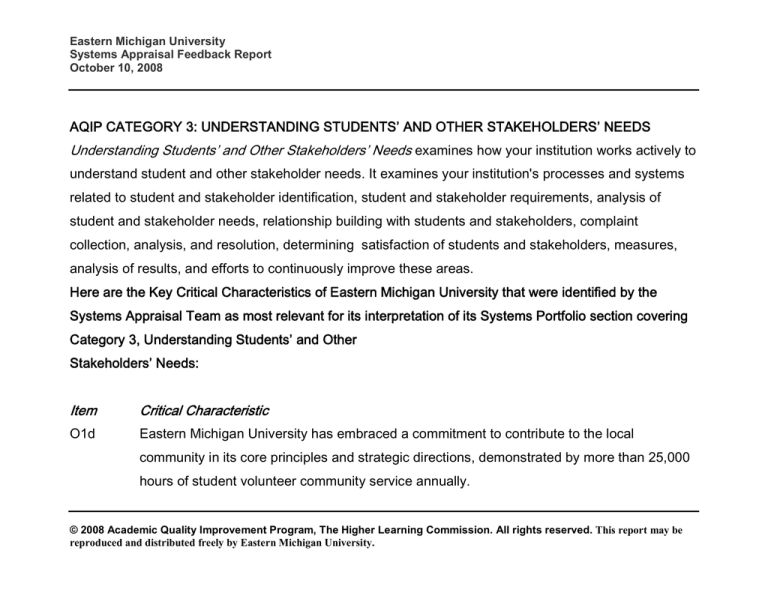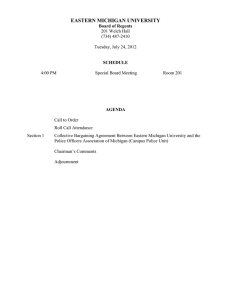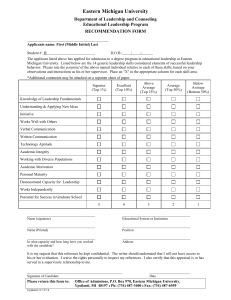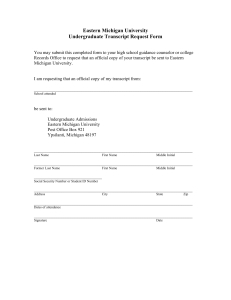
Eastern Michigan University Systems Appraisal Feedback Report October 10, 2008 AQIP CATEGORY 3: UNDERSTANDING STUDENTS’ AND OTHER STAKEHOLDERS’ NEEDS
Understanding Students’ and Other Stakeholders’ Needs examines how your institution works actively to
understand student and other stakeholder needs. It examines your institution's processes and systems
related to student and stakeholder identification, student and stakeholder requirements, analysis of
student and stakeholder needs, relationship building with students and stakeholders, complaint
collection, analysis, and resolution, determining satisfaction of students and stakeholders, measures,
analysis of results, and efforts to continuously improve these areas.
Here are the Key Critical Characteristics of Eastern Michigan University that were identified by the
Systems Appraisal Team as most relevant for its interpretation of its Systems Portfolio section covering
Category 3, Understanding Students’ and Other
Stakeholders’ Needs:
Item
Critical Characteristic
O1d
Eastern Michigan University has embraced a commitment to contribute to the local
community in its core principles and strategic directions, demonstrated by more than 25,000
hours of student volunteer community service annually.
© 2008 Academic Quality Improvement Program, The Higher Learning Commission. All rights reserved. This report may be reproduced and distributed freely by Eastern Michigan University. Eastern Michigan University Systems Appraisal Feedback Report October 10, 2008 O1g
Eastern Michigan University has adopted five core principles and four strategic directions
that guide decision making, which emphasize learning, engagement with the community, and
diversity and multiculturalism.
O2b
Students have an opportunity to take classes and complete programs at seven off-campus
locations through continuing education.
O2d
Eastern Michigan University’s new General Education program includes a Learning Beyond
the Classroom component in which students are required to participate in extracurricular and
co-curricular activities.
O3a
Eastern Michigan University has an enrollment of approximately 18,000 undergraduates and
4,900 graduate students and is noted for its ethnically diverse student population.
O3b
Eastern Michigan University is predominantly a commuter institution, with less than 15
percent of students residing near the campus. Nearly all Eastern Michigan University
students work in addition to pursuing their degrees, and more than 60 percent of students
are over age 21.
© 2008 Academic Quality Improvement Program, The Higher Learning Commission. All rights reserved. This report may be reproduced and distributed freely by Eastern Michigan University. Eastern Michigan University Systems Appraisal Feedback Report October 10, 2008 O4a
Eastern Michigan University collaborates through accreditation agencies, businesses,
centers and institutions, targeted industry grants, research grants and agreements,
nonprofits, advisory boards and steering committees, community colleges, and K-12 districts.
O7b
Eastern Michigan University has established 75 articulation agreements with 13 community
colleges, along with onsite baccalaureate programs at one community college. The
University considers community colleges partners as much as competitors.
Here are what the Systems Appraisal Team identified as Eastern Michigan University’s most important
strengths and opportunities for improvement relating to processes encompassed by Category 3,
Understanding Students’ and Other Stakeholders’ Needs.
Item
S/O
3P1
S
Comment
The University clearly identified a variety of formal and informal means to identify
student needs. Some of the formal means included AQIP Project Advising
surveys, CIRP, the Graduating Senior Survey, and the Noel-Levitz Student
Satisfaction Inventory. Examples of the informal means include feedback from
© 2008 Academic Quality Improvement Program, The Higher Learning Commission. All rights reserved. This report may be reproduced and distributed freely by Eastern Michigan University. Eastern Michigan University Systems Appraisal Feedback Report October 10, 2008 the Division of Student Affairs Student Leadership Group and academic
departments.
3P1
O
Eastern Michigan University indicated that the processes for analyzing and
processing data and selecting a course of action occurs at the department level.
However, the specific steps of the process are not clearly delineated. It is unclear
to what extent these decentralized plans are aligned with each other and with
University goals.
3P2
S
Eastern Michigan University builds relationships with current and prospective
students largely through key student services, such as orientation, advising and
co-curricular and extracurricular activities. These processes have been
influenced by initial AQIP Action Projects. Students are also involved in major
University committees, including a committee of the Board of Regents.
3P3
O
While both formal and informal surveys are used for collecting data about needs
and requirements of other stakeholders, including alumni, parents and
employers, the University was not specific about steps related to analyzing and
communicating the needs. The University may benefit from more systematic
© 2008 Academic Quality Improvement Program, The Higher Learning Commission. All rights reserved. This report may be reproduced and distributed freely by Eastern Michigan University. Eastern Michigan University Systems Appraisal Feedback Report October 10, 2008 methods for analyzing and sharing stakeholder information through attention to
validated processes.
3P4
S
Eastern Michigan University described various activities that take place related to
building and maintaining a relationship with key stakeholders. Some of the
activities include maintaining relationships with high schools and community
colleges, participating on community boards and councils, and meeting with state
senators and representatives. Further, the University creates and establishes
partnerships by allowing key stakeholders to serve on institutional committees.
3P5
O
The University has identified a wide-range of information sources among student
and stakeholder groups. However, it is unclear whether any systematic
processes are in place for analyzing and effectively utilizing the findings in order
to determine new student and stakeholder groups. Efforts to insure that the
extensive information gathered is used for future initiatives are important
components to these processes.
3P6
O
While the University is to be commended for instituting mechanisms by which
complaints can be filed (both academic and non-academic concerns), the system
© 2008 Academic Quality Improvement Program, The Higher Learning Commission. All rights reserved. This report may be reproduced and distributed freely by Eastern Michigan University. Eastern Michigan University Systems Appraisal Feedback Report October 10, 2008 would be better validated if the portfolio addressed the second question about
how complaints are analyzed and communicated as both process and results.
3P7
S
Surveys used to obtain information on stakeholder satisfaction are identified in
Figure 3.2. Annual satisfaction surveys address housing and dining, alumni
evaluations, commuter concerns, new graduates and first-year students.
3R1
O
While Eastern Michigan University provides a description of several surveys and
their key results; it is difficult to provide feedback without seeing a far richer set of
data which include results, trends, and comparisons.
3R2
S
Based on the several results provided, Eastern Michigan University appears to
have good relationships with students related to seeing an academic advisor
(85%) and graduating seniors reporting that they had a positive relationship with
faculty (85.9%).
3R2
O
While Eastern Michigan University provided some student relationship building
data and results, there is a lack of data and results related to all key student
categories. For example, the data and results did not reflect international,
© 2008 Academic Quality Improvement Program, The Higher Learning Commission. All rights reserved. This report may be reproduced and distributed freely by Eastern Michigan University. Eastern Michigan University Systems Appraisal Feedback Report October 10, 2008 graduate, commuter, or residential students. Some of these key groups might be
included in the aggregated data—but there was no segmentation of results.
3R3
S
Figure 3.3 sets forth results from alumni surveys. Parents and community
stakeholders have also been surveyed with positive results reported.
3R4
S
The University identifies an increasing number of articulation agreements with
community colleges, the number of high school counselor workshops, community
discount cards for students, grants from the American Honda Foundation,
Upward Bound support and other partnership successes as evidence of results
for building relationships with key stakeholders.
3R5 O
Overall, Eastern Michigan University’s NSSE results are set forth in Figure 3.4.
Eastern Michigan University is able to use NSSE results to compare student
engagement evaluations with other institutions. While these results are useful,
the University could provide for a broader range of comparisons by exploring
some additional measures with comparable institutions.
3I1-3I2 O
Currently, the University reports no implementation of improvements based on
processes or results which address student and stakeholder needs.
© 2008 Academic Quality Improvement Program, The Higher Learning Commission. All rights reserved. This report may be reproduced and distributed freely by Eastern Michigan University.



